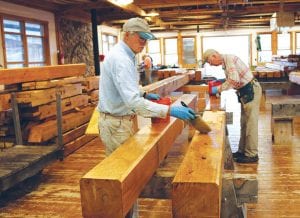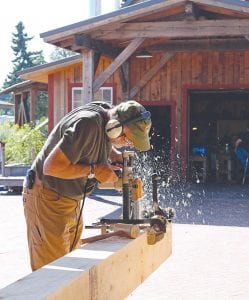A lot was happening at Chik-Wauk Museum and Nature Center last summer. And there is a lot more to come, thanks to a team of energetic volunteers who spent over 1,600 hours and traveled nearly 8,000 miles over the summer to learn the art of timber framing at North House Folk School. Chik-Wauk volunteers and North House staffers worked side by side to create a massive timberframe that will serve as a watercraft exhibit building.
Gunflint Trail Historical Society Board Member Dave Tuttle said while the historical society and museum staff were working to get the new Nature Center and administrative building completed for the May 28, 2016 opening, overseen by volunteer Bob Baker, another group was already moving ahead with plans for another structure.
Bruce Kerfoot, former owner of historic Gunflint Lodge, knew the historical society wanted a large pavilion to set up on the pond at the Nature Center to house watercraft from the past. “Knowing the expense of hiring someone to do such a project, Bruce told the historical society board that ‘we’ should do it,” said Tuttle with a laugh.
His suggestion that “we” do it wasn’t taken too seriously until Kerfoot, who is also involved with North House Folk School, devised a plan to get the two nonprofits together to build a timberframe pavilion—a massive 24-foot by 36-foot pavilion.
All they needed, Kerfoot learned, was 18 volunteers willing to make the commitment to work with Peter Henrikson and Tom Healy of North House from 9 a.m. to 5 p.m. from August 12 – 21. The historical society wasn’t sure they could find 18 people to take on such an activity, but volunteers came forward to tackle the task.
Tuttle said there were a few carpenters, but the majority of volunteers were new to woodworking, like Barb Bottger of Grand Marais, who said, “It was my first venture or adventure with timber framing. In fact I had never run a saw before this time!
“I enjoyed learning and trying out the skills. I mostly enjoyed the teamwork and camaraderie of the 18 volunteers. We came with a variety of skills and experience with woodworking and all of us were challenged with the process.
“There was one other woman, Jane Laurence, who was the most experienced with timber framing. She was also excellent at teaching me and others how to sharpen a chisel!” said Bottger.
Volunteers came from the Gunflint Trail and beyond, some from Duluth or the Twin Cities. Old friends stopped by to lend a hand too. Former U.S. Forest Service Supervisor Jim Sanders helped out for three days. Former Gunflint District Ranger Earl Niewald, who served in Cook County when Chik-Wauk Lodge was still in business, visited.
“All the volunteers had a deep connection to the Gunflint Trail,” said Bottger. “We all took pride in knowing we had a part in building this boat pavilion that will help tell the story of the Gunflint Trail.”
Tuttle was one of the first volunteers to sign up and he told the News-Herald it was quite an adventure. Working in pairs, the volunteers were given some classroom instruction and then received blueprints for carving about 130 giant white pine timbers.
Tuttle explained, “You start out really slow. We penciled it out, with Peter [Henrikson] supervising, checking that the pencil work was correct. Then he gave us permission to start cutting and sawing.”
Tuttle admits that a few mistakes were made, but said, “If someone made a mistake on a timber, you just adjust the carving on another.”
Forget mistakes, were there any injuries? Tuttle laughed, “No major injuries, other than a few cuts and bruises. Oh, there was one fellow who dropped a chisel and had to have 10 stitches.”
Bottger said, “It is important to include how wonderful the community of North House is. It felt like we were on a retreat or at camp. Peter and Tom were awesome at setting that tone and creating a positive atmosphere.”
With their guidance, the students worked quickly enough to finish the carving in time to clean and stain the timbers so they are ready for installation in the spring.
What happened to the timbers in the meantime? Tuttle said they are currently being stored in a building at Hedstrom Lumber Company. Quite fitting, he added, as that is where the majority of the timbers were milled. Timbers larger than 16 feet were milled by Kent Anderson of Maple Hill.
The timbers will wait there until spring when the volunteers will be invited back to help erect the pavilion on the little bay where the Chik-Wauk Lodge boathouse once stood. Henrikson and Healy will direct the installation, which will be another adventure, said Tuttle. “They are talking about erecting it the old-fashioned way, using pulleys and ropes,” he said.
How will the workers know what timbers go where? Tuttle said each piece is numbered and marked in a book detailing the assembly. And the numbers correspond with the people who worked on them. “That might be a good thing—or a bad thing,” chuckled Tuttle. “If a piece doesn’t fit right, everyone will know whose it was.”
No worries, there will be chisels and tools on hand. “But hopefully we won’t need them,” said Tuttle.
Once in place the boathouse will provide space to display vintage boats, old motors—and a jewel in the Gunflint Historical Society collection, Benny Ambrose’s birchbark canoe.
It is estimated that the total cost of constructing the timberframe pavilion will be $175,000, which has been covered by $40,000 of the museum’s $250,000 Minnesota Arts and Cultural Heritage grant; $10,000 from the Lloyd K. Johnson Foundation, private contributions and sweat equity from numerous volunteers.
“It was challenging, a bit intimidating and a lot of work,” said Tuttle, adding, “It was one of the most wonderful experiences most of us has ever had!”




Loading Comments